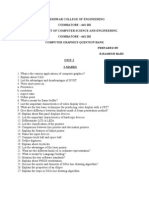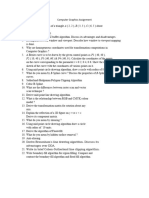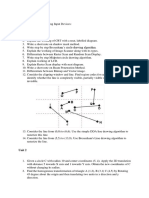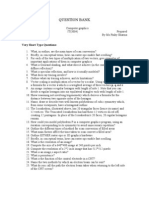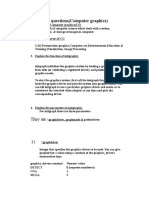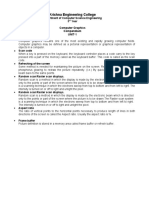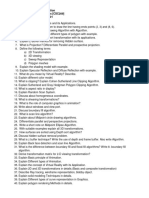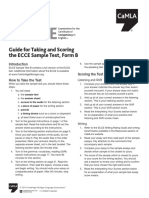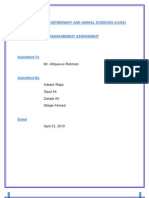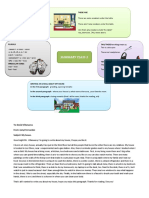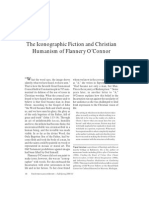OLD QUESTION (2073-2079)
Chapter one: Introduction
1. What is computer graphics? Find the access time per pixel required to access the screen of size
12X 9.5 inches at the rate of 60 frame per second.
2. Distinguish between Raster and Vector graphics with suitable example. When do we prefer
them?
3. What is computer graphics? Calculate the total memory required to store a 10 minute video in
SVGA system with 24-bit true color and 60 fps refresh rate.
4. Compare Raster-scan Display with Random-scan Display.
5. Differentiate between raster and vector graphics. Calculate the frame buffer size (in KB) for a
raster system recording a video for 1 min with resolution of 1280x1024, and storing 24bits per
pixel with a refresh rate of 25 fps.
6. Define Computer graphics. Illustrate about components for computer graphics.
7. Compare random and raster display technology.
8. What do you understand by raster display technology? Suppose a RGB raster system is to be
designed using an 8 inch by 10 inch screen with a resolution of 100 pixels per inch in each
direction. How long would it take to load this raster system in frame buffer with 24 bits per
pixel, if bits can be transferred per second?
Chapter two: Scan conversion
1. Derive the condition to differentiate region 1 and region 2 in midpoint ellipse algorithm. Digitize
the line with endpoints A(10,5) and B(20,12) using Bresenham’s Line Algorithm.
2. Digitize the endpoint (20,10) and (30,18) using Bresenham’s algorithm. How the demerits of
DDA is addressed in Bresenham’s algorithm.
3. Write an algorithm for drawing a circle. Using midpoint circle drawing algorithm, calculate the
coordinates on the first quadrant of a circle having radius 8 and centre (10,10).
4. Write the advantages of Bresenham’s line drawing algorithm. Digitize the Ellipse with radius
Rx=12 and Ry=7 and centre (19,10).
5. Explain the process of drawing ellipse in a raster graphics. Determine the pixel positions of
following curve in first quadrant using mid-point algorithm.
6. Differentiate between DDA and Bresenham line drawing algorithm. Explain Bresenham line
drawing algorithm and use this algorithm to draw a line with end points (25,20) and (15,10).
7. How symmetry property of circle reduces complexity to draw a complete circle. Derive decision
parameter for midpoint circle algorithm assuming the start position as (-r,0) points are to be
generated along the curve path in counter clockwise direction.
8. How decision parameters can be used to draw circle? Calculate the points to draw a circle
having radius 5 and center as (10,5).
� 9. Derive and write midpoint algorithm for drawing a circle.
Chapter three: 2D transformation
1. Define window and view port. Describe about two-dimensional viewing pipeline with matrix
representation at each steps.
2. Derive the window to view port transformation Matrix.
3. Prove that two successive rotation operations are additive in composition transformation. Find
the clipped region in the window of diagonal vertex (10,10) and (100,100) for line P1(5,120) and
P2(80,7) using Liang-Barsky Line Clipping Algorithm.
4. Derive the composite matrix for rotation about arbitrary point (a,b) in clockwise direction with
angle (ϴ). Write an algorithm for Cohen Sutherland line clipping algorithm.
5. Reflected the triangle ABC about the line 3X-4Y+8=0. The position vector of the coordinate ABC
is given A(4,1), B(5,2) and C(4,3).
6. What do you mean by homogeneous coordinates? Rotate a triangle A(5,6), B(6,2) and C(4,1) by
45⁰ about an arbitrary pivot point (3,3).
7. Write matrix for 2D reflection about axes. Derive the transformation matrix responsible for the
reflection of 2D object about line y+x=0.
8. Reflect the triangle ABC about the line 3X-4Y+8=0 the position Vector of coordinate ABC as
A(4,1), B(5,2) and C(4,3).
9. Explain Sutherland-Cohen clipping algorithm with an example.
10. Clip the line P1P2 with P1(-5,3) and P2(15,9) with clip window having diagonal coordinate (0,0)
and (10,10) using Liang-Barskey line clipping method.
11. What are the different steps of two dimensional world to screen viewing transformation?
Describe with matrix representation at each steps.
12. Obtain the end points of the line that connects P1(0,120) and P2(130,5) after cohen sutherland
clipping. The clip window has the following parameters.
Xwmin=0, Ywmin=0, Xwmax=150 and Ywmax=100
Chapter four: 3D transformation
1. Derive an expression for Perpective projection of a 3D point. Also, obtain perpective projection
co-ordinates for the pyramid with vertices of base (15,15,10), (20,20,10), (25,15,10), (20,10,10)
and apex (20,15,20) given that Zprp=20 and Zvp=0.
2. What is Projection? “ The perpective projection is called as realistic projection” why? A rectangle
parallelepiped has its length as 3 unit, 2 unit and 1 unit in x,y,z axis respectively. Perform 90
degree rotations about x-axis.
3. What are 3D Rotation and Shearing? Explain with matrix representations. A unit length cube
with diagonal passing through (0,0,0) and (1,1,1,) is sheared with respect to yz place with shear
constants=2 in both directions. Obtain the coordinates of all the corners of the cube after
shearing.
� 4. Describe 3D viewing pipeline. Derive completer world to viewing coordinate transformation
matrix.
5. List down the steps for rotating a 3D object by 90⁰ in counter clockwise direction about an axis
joining end points (1,2,3) and (10,20,30). Also derive the final transformation matrix.
6. Explain with a block diagram about the 3D viewing pipeline. Along with the transformation
matrix, describe how perpective projection is performed?
7. Develop the Matrix to transform an object from Three-Dimentional World Coordinate to
Viewing Coordinate system. A unit length cube with diagonal passing through (0,0,0) and (2,2,2)
is shared with respect to ZX-plane with share costants=3 in both directions. Obtain the final
coordinates of the cube after shearing.
8. Describe 3-D viewing pipelining. Derive the transformation matrix for perspective projection?
Explain with examples.
9. Explain the steps required to rotate an object in 3D about a line which is not parallel to any one
coordinate axis.
10. Describe three dimensional viewing pipelining. Derive the transformation matrix for parallel
projection
Chapter five: Curve modeling
1. Define convex hull and control graph. Explain parametric cubic curve.
2. What is Parametric Cubic Curve and why do you need it? Write down the step for cubic spline
interpolation.
3. It is necessary to construct curves using parametric equations? Justify. List down the steps for
modeling curves using splines.
4. Differentiate between Interpolation and approximation. Explain the process of performing curve
modeling using splines.
5. Mention two important properties of Bezier Curve and find the Bezier Curve which passes
through (0,0,0) and (-2,1,1) and is controlled by (7,5,2) and (2,0,1).
6. Find the coordinates at u=0.25,0.5 and 0.75 with respect to the control points (10,10),
(15,25),(20,30), and (25,5) using Bezier function. Draw your curve with given control points.
7. Use Liang Barsky line clipping alogithm to clip a line starting from (5,100) and ending at (60,5)
against the window having its lower left corner at (10,10) and upper right corner at (90,90).
8. Find the coordinates at U= 0.25, U=0.5 and U=0.75 with respect to the control points (2,10),
(6,20), (12,5) and (16,15) using Bezier function. And plot Bezier curve with your calculated
coordinates.
9. Explain properties if Bezier curve. Find the coordinate at u=0.2 with respect to the control points
(1,1), (4,6), (8,3) and (12,2) using Bezier function.
10. Explain about parametric cubic curve? What is Bezier Curve? Explain its properties with
examples.
�Chapter Six: Surface modeling
1. What is surface modeling? How can you calculate the normal vector? Explain the importance of
normal vector.
2. What is Wire-frame model and why do we need polygon data table? Explain with examples?
3. Why do we use geometric tables and attribute tables for defining a polygon surface? How do
you calculate the spatial orientation of a polygon?
4. How can we model cone or cylindrical like surfaces using boundary representation and
technique?
5. Represent the following surfaces by polygon table method and find the normal of surface S1.
6. How can a 3D-Dimensional object be modeled? How a normal to a plane of this object is
calculated?
7. Explain Geometric tables are used to represent a 3D object? Explain with example. Give
conditions to generate error free table.
Chapter 7: Visible Surface Determination
1. Compare and Contrast object space method and image space method. Explain scan line method
of visible surface detection in detail. When do we need depth calculation in this method?
2. Describe Z-Buffer method of visible surface detection. Compare this method to other methods
of visible surface detection.
3. What is the limitation of Z-buffer method? How does A-buffer method overcome it, explain?
4. Explain Back-Face detection algorithm for visible surface detection. Find the visibility for the
surface BED and ABCD where observer is at P(5,5,5).
5. How hidden surfaces can be removed? Explain in detail about depth buffer methods.
6. Explain backface detection algorithm. Determine whether two surfaces of a object with normal
2i-3j+4k and i+j-2k respectively, viewed from a direction given by i-j+k are backface or frontface.
� 7. Do you agree Polygon Descriptions are referred to as “Standard Graphics Object”, If yes, why? If
you have three coordinates (x1,y1,z1), (x2,y2,z2) and (x3,y3,z3), then how do you find the
coefficient of Surface Normal N(A,B,C)?
8. What are the consideration factors to choose the Visible Surface Detection Algorithm? What are
the two classes of visible surface detection techniques, explain? What is limitation of Z-Buffer
method? How does A-Buffer method overcome it, explain?
9. Differentiate image space and object space method for visible surface determination. Explain
scanline method to determine visible surface of object.
Chapter 8: Illumination and Surface Rendering methods
1. What is match band effect on rendering? Explain phong and fast phong shading model in detail.
2. What do you understand by diffused and specular reflections and explain in detail how these
terms are included in illumination model?
3. Derive the expression to calculate the total light intensity in a point.
4. Define the term illumination and rendering. Write down the steps for Phong Shading method.
5. Compare and constrast between Gourand and Phong shading model.
6. Define the term surface rendering with Illumination model. Derive an expression to calculate the
intensity of Diffuse reflection with necessary equations and figures. How do you consider the
distance to calculate the intensity for Specular and Diffuse Reflection?
7. What is Phong shading method? Can we use this method to reduce Mach-Band effect?
8. List done different types of object and explain how Phong illumination model is used to calculate
intensity in for these objects with mathematical expression.
9. Explain in detail about Phong shading.
10. Derive the expression to calculate the intensity of Specular Reflection in the presence of Point
light source. Also write the expression for multiple light sources. How do you consider the
distance to calculate the intensity for Specular Reflection?
11. Write down an algorithm for intensity interpolation shading scheme.
12. What is the difference between object space method and image space method for visible
surface determination? Describe scan line method to find visible line with example.
13. Compare the Gourand shading with Phong shading. Develop the expression for Phong model
considering the intensity attenuation for multiple point light sources with necessary figures.
14. Develop a phong illumination model. Show how this model is used for rendering by deriving of
expression for phong shading.
15. Find out intensity of light reflected from the midpoint P on scan line y=3 in the above given
figure using Gourand shading model. Consider a single point light source located at positive
infinity on Z-axis and assume vector to the eye as (1,1,1). Given d=0, k=1, Ia=1, IL=10,
Ks=2,Ka=Kd=0.8 for use in a simple illumination model.
� 16. Define and explain the term ambient light, diffuse reflection and specular reflection with
appropriate mathematical expressions.
17. Explain the method of Phong shading for polygon rendering.
Chapter 9: Introduction to Open GL
1. What are the uses of GL, GLU and GLUT/AUX in openGL? Explain naming convention of a
OpenGL function with syntax.
2. Write down the Open GL syntax to draw basic 2D geometric primitives with examples.
3. What is OpenGL? How can we draw colored line and polygon using OpenGL?
4. What do you mean call back function? Illustrate with example.
5. What is OpenGL? How pixels, lines and polygon is drawn and transformation is performed in
OpenGL?
6. How polygon is drawn in OpenGL? How lighting is applied to this polygon surface?
7. What is OpenGL? Explain Call back function?

